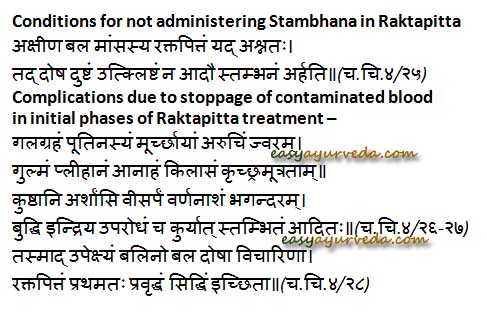Stambhana in Raktapitta: Styptic Therapy In Bleeding Disorders
Article by Dr Raghuram Y.S. MD (Ay) & Dr Manasa, B.A.M.S
Raktapitta is a bleeding disorder explained in Ayurveda. When there is bleeding we generally think of stopping the blood flow as an immediate measure and point of emergency. But in Raktapitta it is not the Jeevarakta (fresh blood) which is flowing out of the body orifices, in fact it is the blood which has been contaminated by pitta which is flowing out (hence the name Raktapitta to the disease).
Since the body is trying to expel the contaminated blood, it should be allowed to bleed out. If this blood stays back in the body it is going to produce severe complications and damage.
Therefore, Sthambana Chikitsa or measures and treatments to stop the bleeding should not be implemented in the initial stages of Raktapitta.
Related Reading Raktapitta: Cluster Of Bleeding Disorders: Meaning, Definition

Contraindication of stambhana
Conditions for not administering Stambhana in Raktapitta
A wise physician should not make attempts to stop the blood which is aggravated and contaminated with pitta i.e. Sthambana or treatment to stop bleeding should not be done in the initial phases of the treatment provided the below mentioned conditions prevail –
- Aksheena bala – The patient has conserved and preserved his strength
- Aksheena Mamsa – The patient whose muscle mass is well preserved (has good muscle bulk)
- Ashnataha – The patient is able to consume food
In short, in the initial phases of Raktapitta, the bleeding should not be stopped if the patient is strong enough, having good muscle bulk and is able to consume food.
Aksheena mamsa or good muscle bulk indicates good strength and immunity. It is one of the parameters in Ayurveda to access Bala or strength of the patient.
Read related: Raktapitta Causes, Premonitory Symptoms, Symptoms, Pathogenesis
When the patient is able to eat food, it means that his agni or metabolic fire is fine. This shows that the digestion mechanism (metabolism) and nutrition to the body tissues is good. This also reflects the nutritive stage of other tissues, their strength and immunity. Good agni also means less ama (essence of improperly digested food or unprocessed nutritional juice in circulation, which is by itself a toxin). Elsewhere, Charaka tells that more quantity of ama in the body leads to further vitiation and increase in quantity of already aggravated rakta and pitta, thus making the condition worse. This shows that if agni is good, there is less ama, obviously there is less bleeding of contaminated blood. This is favorable for treatment. Since bleeding is less, it can be allowed to flow. Since agni is good, it keeps making good nutritive fluid (rasa) and keeps supporting the tissues and bala.
Read related: Treatment Principles Of Raktapitta – Bleeding Disorders
This also implies that –
Sthambana or treatment or medicaments to stop bleeding can be given if the patient has alpa bala (less strength), has ksheena mamsa (less muscle bulk) and anashnataha (the patient is not in a condition to consume food, i.e. the nutritional status of the patient is very poor)
Read related: Stambhana – Blocking Therapy Principle For Leaking Disorders
Complications of stambhana
Complications due to stoppage of contaminated blood in initial phases of Raktapitta treatment –
If the bleeding is forcibly stopped in the initial phases of Raktapitta, wherein the body is trying to put out the contaminated blood, it causes the below mentioned complications –
- Galagraha – choking or gripping in the throat
- Puti nasya – foul smell in the nose
- Murcha – unconsciousness, fainting
- Aruchi – anorexia, tastelessness
- Jwara – fever
- Gulma – abdominal tumors
- Pleeha – enlargement of spleen (spleenomegaly)
- Anaha – flatulence
- Kilasa – leucoderma, white skin patches
- Krichchra mutrataam – dysuria, difficulty in passing urine
- Kushta – skin diseases
- Arshas – piles
- Visarpa – herpes
- Varna nasha – loss of body color
- Bhagandara – fistula in anus
- Buddhi uparodha – loss of intelligence
- Indriya uparodha – loss of sensory functions
Just Before Finishing
Bleeding from any part of the body is a grave emergency. Raktapitta, termed as Mahagada or dreadful condition by Charaka is the earliest description of bleeding disorders in Ayurveda. Though it is an emergency condition one should know when to stop the bleeding and when not! This article covers the rules of providing stambhana in Raktapitta.
Click to Consult Dr Raghuram Y.S. MD (Ayu)








